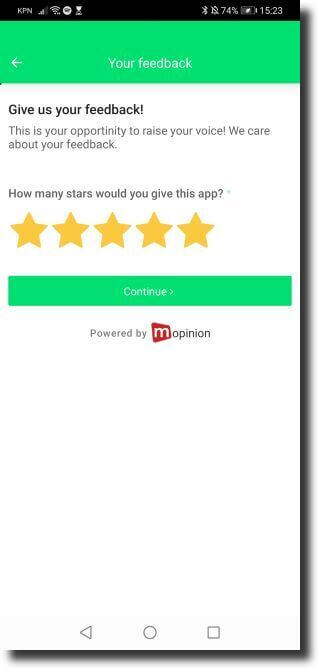In the words of the famous poet Charles Bukowski, “If you’re going to try, go all the way. Otherwise don’t even start.” Well the same can be said about customer feedback. An organisation’s main objective for collecting customer feedback is to deepen their understanding of the customer and how they perceive the digital experience. But what many organisations don’t realise is that these experiences aren’t taking place solely on their website anymore. They are spread across all and any digital channels they leverage to serve their customers, whether that’s the website, their mobile app or even their email campaigns.
If you look at the bigger picture, your customers do not view your digital channels as individual experiences, they see one single brand. So why is it that so many organisations are still only focusing on the website experience?
The answer is simple. Digitally speaking, the website has always been the go-to channel for attracting and retaining customers, maintaining search engine rankings and presenting new information, products and services to customers and prospects. It makes sense, really. It’s within our comfort zone and it’s always proven to be a good platform for business.
But times are changing and the customer is no longer using the website alone to reach his/her online goals. In fact, mobile apps are climbing to the top in terms of popularity, especially among ecommerce businesses and the financial sector. And then, of course, many businesses are still using email campaigns to further their marketing efforts.
By not measuring the performance and customer experience on these channels, your brand is going to fall flat.
European companies with more digital capabilities across channels are able to convert sales at a rate 2.5 times greater than those with fewer touchpoints.
Don’t be a victim of ‘Digital Darwinism’
One term the internet really loves throwing around lately is the term ‘Digital Darwinism’ – an era where technology and society are evolving faster than businesses can naturally adapt. In this era, digital leaders are expected to outperform their competitors simply by having the right digital channels and solutions in place to satisfy customer needs.
Want to avoid falling short when it comes to the digital transformation?
Make sure all of your digital channels are performing optimally with customer feedback.
Why collect feedback across all of your digital channels?
There are several reasons organisations should be prioritising not just one but ALL of their digital channels when it comes to collecting customer feedback, including:
1. You will gain a holistic view of the customer and the digital experience
Oftentimes when we talk about a 360 view of the customer (or holistic view of the customer), we’re talking about having all of our customer data in one single place – like a CRM software. However, having a holistic view of the customer also demands that the collection of that data take place across all possible channels. Otherwise, it’s hardly ‘holistic’.
By only collecting feedback on your website, you limit your reach when it comes to understanding the entire digital experience. In fact, if you are one of these organisations, odds are you are only collecting a fraction of the insights you might otherwise have access to if you were to target all of your digital channels.

Source: enprecis.com
According to a recent Forrester study, ‘33 percent of transactions made by new customers are influenced by more than one touchpoint’. This means that your customers might be conducting their research on one channel, while actually making their purchase on another. All the more reason to have all of your channels optimised and ready to serve your customers.
Customer feedback enables you to gather insights across all of these channels – provided that you have a solution in place that reaches these channels effectively. By analysing key areas of each channel, you can identify where feedback surveys should be deployed and gather relevant and insightful feedback.
2. Different users have different needs
So let’s build off of that concept we’ve mentioned above…
The journeys of these customers – who are using multiple touchpoints – tells us that different ‘demographics and buyers of particular products/services are actually becoming more inclined to use certain channels depending on where they are in their online journey’. This is an interesting concept as this affects how we cater to our customers on our different channels.

Source: Bergast House
In the Consumer Conversation report published by Bergast House and IBM, it was shown that:
- Women will conduct slightly more of their research on a mobile app than men.
- 18-34 year olds have a much higher rate of both researching and buying products in-app compared to older generations.
These differences – though subtle – show that the users themselves have to be delicately taken into account as well.
So you need to look more closely at what is happening.
Are customers actually buying their products on the mobile app? Then we need to make sure the purchasing funnel is fully optimised and ready to serve these customers via the app. Or perhaps you see that customers are doing their research in your app and buying on your website. Then your focus should lie on getting those two channels ‘ready’ for those interactions.
But wait – where does email fit in? Though it may not play a huge role in the research and purchasing processes, email is actually very important for creating awareness about new and improved products and services. Alongside social advertising and loyalty programs, email marketing is there to generate interest and spark curiosity in customers and/or prospects. Therefore sending the right message to these recipients is critical to the entire journey. Hence the power of email feedback.
See how this channel fits in in the illustration below.

Source: Vendasta
3. Different channels will give you different types of insights
As a result of the varying needs of your customers, you’ll soon realise that your digital channels all serve a different purpose and therefore can give you insights into the digital experience that another channel can’t.
For example, your email channel is there to market products / services (i.e. newsletters, promotions) as well as deliver important information to your customers (i.e. service emails, updates). The data you gather from email feedback will therefore give you more insight into the message you send your customers. It will help you determine if this information is informative, as well as give you an indication as to what kind of information your customers want to receive.
Alternatively, the website is your main source of traffic and therefore most critical channel for understanding online customer journeys. There are many different pages on a website, and therefore many different ways in which you can gather insights. By placing a passive feedback survey on your homepage, you can gather insight into the user experience of the website as a whole. Additionally, you can strategically place surveys within certain funnels such as product pages or blog pages and measure if the content on those pages is sufficient. And then of course, there are pages further along in the funnel (i.e purchasing), whereby you’ll want to know if your processes are performing optimally so as to enable the customer to effortlessly achieve their goal of making a purchase.

The mobile app – though similar in many ways to the website – also has its advantages when it comes to gathering specific insights. As we mentioned above, visitors have different goals with different channels. By making sure you understand your mobile users through mobile feedback, you will be able to better understand the mobile experience and how those users are actually using your app (whether that’s for research purposes or actual purchasing).
4. Always room for improvement on all digital channels
Regardless of the digital channels you use, at one point or another, they’re all going to require some maintenance. No single channel is ever really ‘timeless’ or exempt from bugs and errors. So these channels need to be monitored regularly. Customer feedback enables companies to keep a pulse on their digital channels and continuously improve them.
For example, if you see that the mobile app significantly improves the buying experience of your users, you’ll want to be sure that that digital channel is fully optimised and meets the needs of your customer base.
5. One, unified brand experience
In addition to attaining a unified view of your customers across all of your channels, you also want to create a unified brand experience for your customers. That means making sure that all of your channels reflect your brand and ensure a seamless experience for customers. After all, your customers don’t see channels. They see one single brand and therefore have one impression of your brand. ‘
By collecting feedback on your website, mobile app(s) and email, you can tie together the journey and provide an equally valuable experience across all channels.
Most effective digital channels to collect customer feedback
As you might’ve noticed, in this post we focus on the collection of feedback on three key channels: website feedback, mobile feedback, and email feedback.
Let’s take a closer look at each of these individually.
Website Feedback
Website feedback – perhaps the most common of all – essentially helps organisations understand which areas of their website are performing well and which areas require improvement. For example, certain pages that are key to the customer journey. This type of feedback can be collected in a number of ways including via passive feedback surveys (static surveys that are deployed using a feedback button) whereby the visitor can submit generic feedback about the website. Website feedback can also be submitted via embedded surveys (built into the page) or as a pop-up / slide-in survey, which is also referred to as an active feedback survey.

Source: Vodafone Ireland
Read more about website feedback here.
Mobile Feedback (or In-App Feedback)
Mobile feedback has become a very powerful type of feedback in the last few years, especially as mobile devices continue to climb the ladder in terms of usage. So what does it do? This type of feedback gives organisations the opportunity to collect feedback in a way that suits (native) mobile apps. After all, the screen is different, space is limited and usability is even more critical with this channel. Therefore providing feedback must be an effortless process that requires a different approach.
In addition to mobile-specific targeting techniques, some customer feedback software offer solutions that enable users to gather mobile metadata and capture in-app screenshots (or visual feedback) to better define mobile issues.

Source: Recharge.com
Read more about mobile feedback here.
Email Feedback
Lastly, it is important to incorporate email feedback into your greater feedback strategy. This type of feedback enables companies to create a platform for two-communication with customers who receive their emails. These customers can share their perceptions of your email campaigns and the content in those emails.
There are a number of ways to collect email feedback. Perhaps the most common and simplistic method is by embedding a survey into the bottom of the email with a ‘thumbs up’ and thumbs down’ option. This type of survey is often used in newsletters and service emails which happen to be very content-rich. There are also some other types of email feedback surveys including: email survey invites (via a landing page) and email signature feedback.

Source: DHL
Read more about email feedback here.
Be smart about your online presence
Your brand’s online presence is extremely important in this day and age – which makes it particularly crucial that this presence is the same across all of your digital channels. And really the only way to do that is to check in with your customers and ensure the experience is up to par with their expectations, whether that’s on your website, mobile app or within your email campaigns.
In other words, it’s time to bring all of these channels together.
Mopinion offers an all-in-one user feedback solution that helps organisations create a frictionless digital experience across all of their channels. With solutions specially made for your website, mobile app and email campaigns, you can keep a pulse on the channels that matter most.
The solution has an easy-to-use interface, with which users can build, design and configure feedback surveys however they like. Mopinion users can also target specific groups of visitors with feedback forms and gain insights into why they are struggling to convert. Once collected, feedback items can be visualised in customisable dashboards and charts for advanced analyses. Additionally, digital teams can share and take action on these feedback items in a timely manner with the help of smart alerts.
Ready to see Mopinion in action?
Want to learn more about Mopinion’s all-in-1 user feedback platform? Don’t be shy and take our software for a spin! Do you prefer it a bit more personal? Just book a demo. One of our feedback pro’s will guide you through the software and answer any questions you may have.






